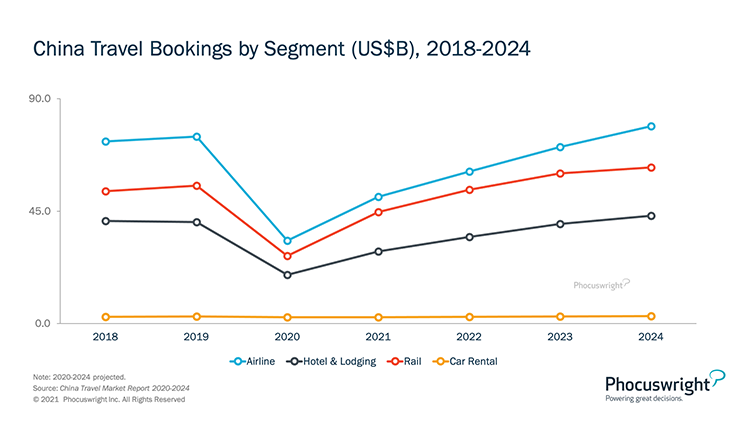A snapshot of airlines, hotels & lodging, rail and car rental in China
- Published:
- July 2021
- Analyst:
- Phocuswright Research
China's travel market contracted by 53% in 2020. According to Phocuswright's recently published travel research report China Travel Market 2020-2024, a baseline scenario assumes that domestic travel demand in 2021 will approach 2019 levels, enabling 54% growth that would push total travel bookings to US$127 billion.
Here's a look at key trends and data for major segments in China's travel market.

(Click image to view a larger version.)
Airlines:
More than half of air is sold online in China, and online penetration grew in 2020. OTAs accounted for 54% of 2020 online bookings, but suppliers are projected to gain back two points of share in 2021. As true leisure travel and international trips,return, the balance will swing back slightly to OTAs, where travelers can compare pricing from different carriers and plan and purchase their complete trip.
Hotels & Lodging:
Over the past 10 years, China's hotel market has become one of the world's most consolidated, more comparable to the chain-dominated U.S. than to the independent-driven India and Europe. The country's top 50 chains account for more than 80% of room supply, mostly owned by three hotel groups: Jinjiang, Huazhu and BTG. OYO Hotels claims to have half a million rooms in China, but its numbers are difficult to verify, and leadership has hinted at difficulties in China during 2020.
Rail:
While the railway's own channels account for more than half of digital sales, third parties have been gaining share. Ctrip and Alibaba-owned Fliggy have made selling rail a priority because it is such a common travel purchase, even though they do not earn any commissions on rail. OTAs have made up for the lack of commission to some degree by charging service fees and attaching trip insurance by default, but recently have relied more on cross-selling other travel products.
Car Rental:
Small independent players still make up more than half of China's car rental market. The two biggest - eHi and CAR Inc. - account for about 40%. The segment has advanced quickly with the growth in licensed middle-class drivers and massive highway improvements.
CAR Inc. and eHi both generate more than 80% of their bookings online, but smaller players have the opposite distribution mix, so overall 41% of car rentals were booked online in 2020. The biggest determinant of a future shift toward more online bookings will be segment consolidation, which so far is happening very slowly.
This publication provides an overview of the China travel market, including key developments, market characteristics, distribution trends and major players in each segment. For more detailed data and analysis, see the following related publication:
China Travel Market 2020-2024: By the NumbersTo give access of this report to your entire company, subscribe to Open Access. Plus, everyone in your organization will have access to the entire Phocuswright research library and data visualization tools.











